Innovations expand applications beyond ablation and tissue removal to include bioresponse and drug delivery.
For medical lasers, the future may include both addition and subtraction. That’s because in medicine, lasers have traditionally been used for ablation, cutting and other processes that remove tissue. Now researchers and companies are looking into harnessing the power of light to stimulate a bioresponse, thereby triggering growth and ushering in an additive approach.
The key for either subtraction, addition or a combination is to get the right wavelength to the right spot at the right intensity and duration. Beyond that, systems have to allow a fast learning curve so that they’re usable by a broad audience of nonlaser experts. They also have to be the right cost.
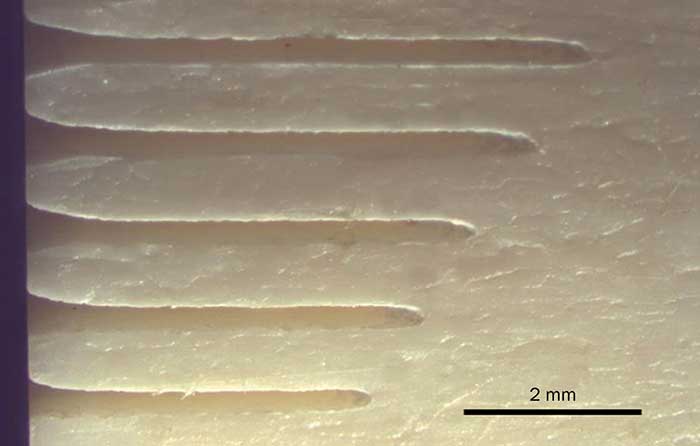
Lasers cut bone to a depth greater than 6 mm with a high aspect ratio. Courtesy of Pantec Medical Laser.
“In order to enable a higher penetration of our technologies, we must strive to make them even more affordable and intuitive for new users,” said Amir Lichter, vice president of product delivery and life cycle at Yokneam, Israel-based Lumenis Ltd., a laser- and energy-based medical device supplier.
One key to cutting costs is complete control over the manufacturing cycle, Lichter said. Another is to seek alternative energy-based technologies for some clinical applications that can deliver results at a lower cost than lasers. Lumenis, which is celebrating a half century in medical lasers, also offers intense pulsed light and radio-frequency-energy-based solutions for an array of medical applications.
Lumenis uses CO2 lasers, which emit at 10 microns in ear, nose and throat as well as gynecological and dermatological applications. The company employs holmium solid-state lasers with a wavelength of 2.04 µm for the treatment of benign prostatic hypertrophy, stone dusting or the breaking up of stones and other urology applications. When it comes to aesthetic and dermatology procedures, Lumenis turns to 1064-nm wavelength Nd:YAG lasers to treat vascular conditions, while employing CO2 and 1565-nm Erbium lasers for skin resurfacing and diode lasers for hair removal. Doubling the Nd:YAG to the green by passing the light through a KTP crystal yields devices used in ophthalmic treatment.
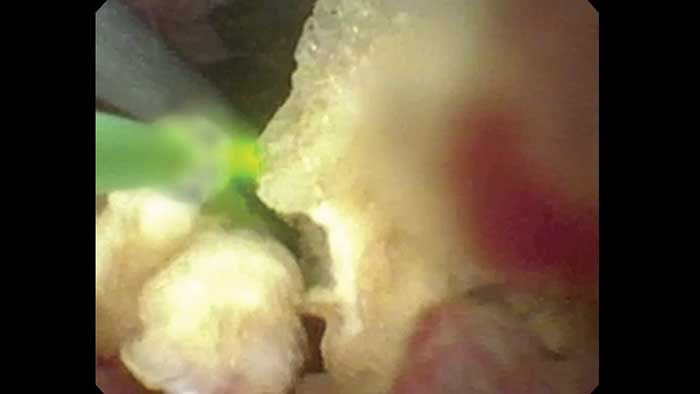
A laser breaks up urinary stones. Courtesy of Lumenis Ltd.
The power ranges from a watt for retinal treatments up to 120 watts for urology
applications. Some of these are pulsed while others are continuous wave, with the specific treatment dictating which approach is best.
Smooth, ablative cuts
Lichter pointed to a trend that will push laser innovation. “More effective solutions can be obtained by combining two different sources of lasers or even two different energy-based technologies,” he said.
An example includes the use of radio frequency to pretreat an area, thereby boosting laser penetration. Another possibility is the use of one laser to make a smooth ablative cut while a second at a different wavelength stops bleeding. This is possible because of differing blood absorption characteristics of the two beams.
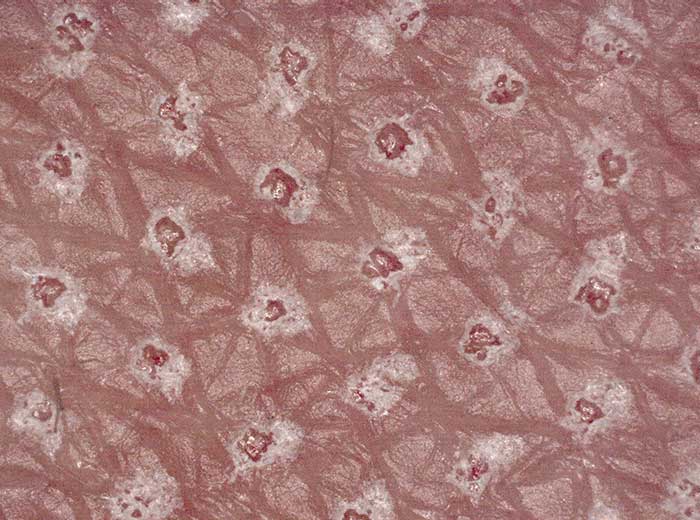
Skin perforated by laser shows no blood. This treatment can ease the delivery of drugs through the skin. Courtesy of Pantec Medical Laser.
To do this, the lasers must be integrated into a system while taking up less space, power and other resources. They also need to be more robust in order to achieve an acceptable uptime.
Further changes that Lichter sees coming include guided real-time imaging to increase the effectiveness of treatment and improve the safety of an operation. Again, this integration will be aided by laser improvement. So, too, will creating more cost-effective solutions, a third upcoming trend.
Laser parameters such as wavelength, power and pulse duration are important and must fit the desired application, said Lichter. Just as critical is that the systems are reliable, intuitive to operate and easy to use because ultimately the devices will be operated by medical and not laser professionals.
Lumenis is also researching bio-stimulation, Lichter said. At the moment, though, the company has nothing that can be publicly shared.
Healing effects
The fundamental case for the healing effects of medical lasers seems sound, based on preliminary evidence and the physics involved. Studies at Careggi Hospital in Florence, Italy, for example, have reportedly shown that women who have undergone laser-based cervical disease treatment get pregnant at a greater rate than the normal population. A study of patients at Kaiser Permanente Northwest1 found the same, with laser and nonlaser treatments included in the evaluation.
At the focus, the power of a laser can heat tissue to thousands of degrees, but does so for only microseconds if it is pulsed. This is the physics behind the case for the healing effects of medical lasers. As a result, diseased tissue is destroyed, but the surrounding healthy tissue is unharmed. However, the surrounding tissue is still exposed to intense and potentially healing light, with this falling off with distance from the focal point.
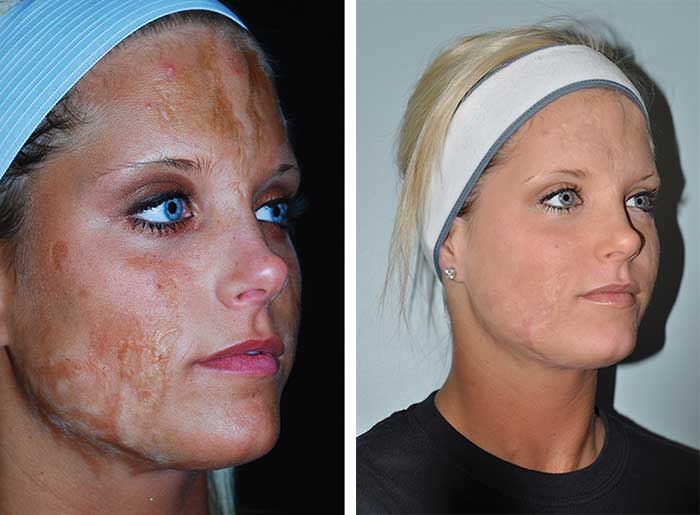
Scar revision using an ultrafast CO2 laser before (left) and after (right). Courtesy of Lumenis Ltd.
Proving that benefit scientifically is difficult and the burden of evidence for a medical claim is high. Biostimulation is an area of great interest, however, and so it may not be long before there are confirming studies.
For example, according to Deka, a spinoff of the El.En. Group S.p.A. of Florence, Italy, studies are underway of the wound-healing effects of its CO2 laser system. These are being conducted to examine the effects of the laser, which the company stated “appears to induce a significant response in terms of inflammation, growth factors expression, collagen regeneration, immune-modulation and neo-angiogenesis (new blood vessel formation).”
The El.En. Group makes medical systems based on CO2, Nd:YAG, holmium, and diode lasers for a variety of medical treatments. Currently, these are used for ablation, cutting or coagulating, depending on the energy density. There is the possibility they will be used for bio-stimulation in the future.
In the meantime, Luca Giannoni, medical R&D product manager, said some of the company’s improvement efforts are centered on scanners, the systems that deliver the laser to the desired spot while moving the beam very rapidly. Scanners need to be both precise in targeting and quick in their response.
Another area of improvement involves various system modules. A laser, unlike a blade, has multiple parameters that can be tuned to give the optimum result. Some of this tuning may not be intuitive to medical professionals.
One such adjustment is focus, which Giannoni noted is an acquired skill that takes time to develop. So the El.En. Group is attempting to make focusing simpler and more effective for professionals who are not experts.
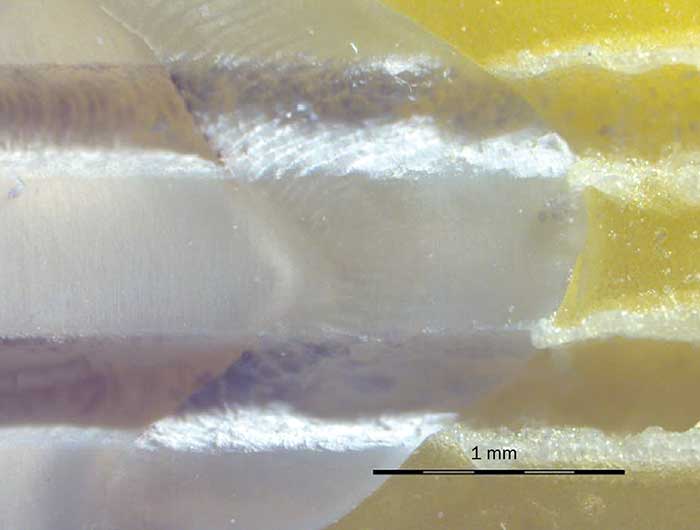
Lasers efficiently cut enamel and dentin. Courtesy of Pantec Medical Laser.
“We are working to make something that is more friendly for them to focus and for them to understand if things are working correctly or not,” Giannoni said.
A much smaller company, Pantec Medical Laser of Ruggell, Liechtenstein, got into the medical laser business as a way to make drug delivery painless, according to Manuel Messner, application and sales engineer. The firm, a division of Pantec Engineering, wanted to use a laser to produce tiny holes in the skin. On top of this would go a patch bearing the drug of interest. The medicine would penetrate the skin and provide a therapeutic effect, courtesy of the laser-drilled perforations.
Ideal wavelength for tissue absorption
Because of the presence of water in biological tissue, Pantec looked at its absorption spectra and decided where the laser output should sit. “Around 3-µm wavelength you see a very high absorption — meaning if you manage to get a laser at that wavelength, all the laser power, all the laser energy is absorbed by the water, giving you desired effects like ablation or coagulation of your soft or hard tissue,” Messner said.
Pantec opted to use an Er:YAG crystal for its optical gain medium, which led to a 2.94-µm wavelength beam. The company went with a direct diode pump instead of flash lamps and chose a monolithic resonator design, leading to better pump light matching and the elimination of external cavity mirrors. This monolithic diode-pumped solid-state design enables the lasers to be compact and robust, opening up the possibility of integration into a handheld unit, Messner said. He added that it also made the lasers efficient and almost maintenance-free.
According to Messner, the chosen laser scheme allows different output wavelengths by careful crystal absorption and pump-wavelength matching. The design also makes upping the power output easier.
What Pantec had at the end was a system that worked well for treating the skin to facilitate drug delivery. The company put the design to use in other medical procedures.
“We took this Er:YAG laser and power-scaled it. We started with 2-watt laser modules 10 years ago and now we are at over 100 watts output power. That opened the way for all kinds of medical applications,” Messner said.
Today, the lasers are used for minimally invasive surgery, dentistry, ophthalmology and dermatology applications, he said. Pantec has added other wavelengths by using Thulium:YAG crystals, which lase at 2.02 µm. The company is also looking into visible wavelength applications, with one planned application being photocoagulation of the retina.
Reference
1. A.L. Naleway et al. (2015). Pregnancy after treatment for cervical cancer precursor lesions in a retrospective matched cohort. PLOS ONE, http://dx.doi.org/10.1371/journal.pone.0117525.